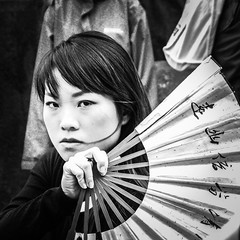 |
| Kind of like this but with more knives. Photo by Elizabeth Ann Duffy. |
The rise of the nouveau riche merchant classes was
deeply dismaying to the old aristocracy. Seeing the wealth of their ancestral
estates completely eclipsed by the new fortunes built on trade, they did what
aristocracies always do when threatened with marginalisation: they fell back on
snobbery. They became sticklers for etiquette and devotees of the most
sophisticated art forms, insisting that true
nobility was something that could not be bought for any price; and it was
in this context that the Jewelled Fan Fellowship first arose. The aristocratic
taste of the day called for immensely complex balletic operas, written in
punishingly difficult verse, because such works allowed them to pride
themselves on their immense sophistication. But finding people capable of
actually performing such works proved
a real challenge; and it was thus necessary to found academies in which the
necessary skills of acting, singing, dancing, verse recital, and musical
performance could be taught. Those who completed their gruelling course of
instruction were given jewelled fans as marks of their excellence, and thus
they became known as the Jewelled Fan Fellowship.
The Jewelled Fan Schools were
founded with aristocratic patronage; but ironically, although probably
predictably, it was actually the merchant houses which turned out to be their
best customers. Everyone knew that hiring Jewelled Fan performers was
fantastically expensive - so what better way to show off your wealth than by
having a hundred of them perform at your wedding? They cultivated an aura of
unattainable glamour, far removed from that of common actors or musicians - so
what a coup to be able to show off a famous Jewelled Fan dancer as your
mistress! Whether or not one actually understood all that complicated
fan-dancing was entirely beside the point - although some merchant-princes in fact became discerning patrons of the
art, even going to far as to compose new ballet-operas for their favourite
dancers to perform. Wherever trade and industry flourished,
there the Jewelled Fan Fellowships flourished also.
The Language of Fans: To play a Jewelled Fan dancer (or a Murder
Harlot), you must have Dexterity and Charisma 14 or higher. Treat them as
tricksters, except that they do not gain a to- hit bonus equal to their level
with ranged attacks and daggers; instead, they gain this bonus only when
fighting with a bladed fan (1d6 damage for Jewelled Fan dancers, 1d3 for anyone
else, cannot be thrown). When fighting with bladed fans (and only with fans), they may choose to
modify their to-hit and damage rolls with Strength or Dexterity, whichever is higher. All Jewelled Fan dancers know
the Language of the Fans, which allows them to communicate rapidly and silently
with one another through gestures made with their fans. Scholars who see such
communications may understand the general gist of it with a successful
Intelligence roll; no-one else will realise that anything has been communicated
at all.
Starting equipment:
Travelling coat (treat as buff jacket, +2 AC), 2 bladed fans (1d6 damage),
pistol (1d8 damage, 3 rounds to reload), 2 jewelled fans worth 50sp each (for
dancing), musical instrument, colourful performance costume, 3d6x10 sp.
Concealed weaponry carried by apparently unarmed Murder Harlots (roll 1d10)
- Bamboo parasol turns out to have a metal core, and has a hidden catch which causes a narrow blade to spring out of the top and lock in place, turning it into a spear (1d6 damage).
- Ornate gown has steel rods sewn into each forearm, allowing the wearer to parry blows with their arms and granting +1 AC in melee only. If torn out of the lining, they can also be used as tonfas (1d4 damage).
- Elaborate hairpin is sturdier and sharper than it looks, and is perfectly usable as a stiletto (1d4 damage) in a pinch.
- Large round buttons on gown actually have razor-sharp edges beneath felt covering; if the felt is ripped off, they can be thrown like shuriken for 1d3 damage.
- Gown contains 1d6 hidden knives (1d4 damage) sewn into the lining, each concealed by a panel of fabric which can be torn away to enable easy access.
- Elaborate gloves contain spring-loaded spikes built into the fingertips, forming makeshift claws (1d3 damage), great for poisoning.
- Soles of slippers contain spring-loaded blades, activated by tapping heels together three times. Blades lock into place in front of toes, allowing people to be kicked to death. (1d3 damage)
- Spiky decorations on necklace can be snapped off and used as darts (1d2 damage). With all its stops closed, bamboo flute doubles as a perfectly serviceable blowgun.
- Concealed gun barrel and trigger built into neck of sitar. Can be used as a rather clumsy pistol (1d8 damage, 3 rounds to reload, -1 to hit).
- All the above. All at once.
"All the above. All at once".
ReplyDeleteThat caught me off guard. :)